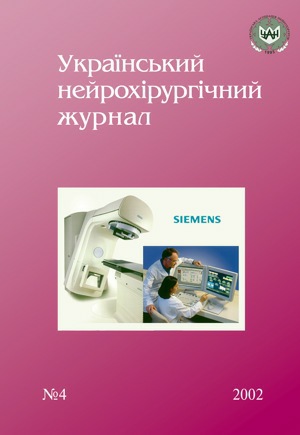The surgical treatment assessment depending on the lower lumbar intervertebral disc hernias location
Abstract
The results of surgical treatment of 100 consecutively selected patients suffering on ruptured discs at LIV—LV and LV—SI levels operated on from 1999 to 2001 in the institute of neurosurgery have been analyzed. Conventional microdiscectomy and interlaminectomy have been used. The causes of disc rupture were excessive physical loading (lifting), forced sport occupations, and trauma (fall). Till the operation was used the main complaints were lumbar pain, pain in the radicular distribution of cauda equina, leg pain, and sensetive and motor disturbances at the interested in roots zones. The results of operative treatment assessment were fullfilled according to the scale, we worked out, included the most objective criterions that allow to assess the adequacy and effectiveness of surgical intervention. Fifty eight percent of patients had an excellent result, 41% - good, and 1% — satisfactory. Obtained data suggest the practical value of the used scale that allows to assess the surgical approaches applied to the ruptured discs of the lower lumbar spine objectively and compare the possible outcomes of surgical interventions depended on intervertebral disc hernias location variants in axial plane and as regard to the radicular parts.References
1. Ahn U.M., Ahn N.U., Buchowski J.M., Garrett E.S., Sieber A.N., Kostuik J.P. Cauda equina syndrome secondary to lumbar disc herniation: a meta-analysis of surgical outcomes //Spine. — 2000. — V. 25, N 12. — P. 1515—1522.
2. Bahra H. 1000 Bandscheiben-operationen in 13 jahreneine bilanz // Beitr. Orthop. Traumatol. — 1979. — N26. — P. 292—295.
3. Benin A. Der lumbale bandscheibenschaden. — Kohlhammer, Stuttgart, Berlin, Kцln, 1991. — P. 148—193.
4. Biehl G., Peters G. Behandlungsergebnisse bei 450 bandscheibenoperationen // Z. Orthop. — 1971. — N109. — P. 836—847.
5. Chang H.S., Nakagawa H., Mizuno J. Lumbar herniated disc presenting with cauda equina syndrome. Long-term follow-up of four cases // Surg. Neurol. — 2000. — N53(2). — P. 100—104; discussion 105.
6. Frenkel H., Angerhofer I. Fruhergebnisse nach lumbaien bandscheiben operationen // Beitr. Orthop. Traumatol. — 1978. — N25. — P. 523—528.
7. Herzberg M. Ergebnisse der operativen behandlung des lumbaien Bandscheibenvorfalles. Dissertation, Medizinische Fakultдt, Universitдt Lьbeck, 1991.
8. Jonsson B., Stromqvist B. The straight leg raising test and the severity of symptoms in lumbar disc herniation. A preoperative evaluation // Spine. — 1995. — V. 20, N1. — P. 27—30.
9. Jonsson B., Stromqvist B. Significance of a persistent positive straight leg raising test after lumbar disc surgery // J. Neurosurg. — 1999. — V. 91 (1 Suppl.). — P. 50—53.
10. Kho H.C., Steudel W.I. Vergleich der mikro¬chirurgischen lumbaien bandscheiben¬operation mit der konventionellen technik beim frei sequestrierten bandscheibenvorfall // Neuro¬chirurgia. — 1986. — N29. — P.181—185.
11. Krenzlin H. Spatergebnisse nach operativer therapie des lumbaien bandscheibenvorfalles. Dissertation, Medizische Fakultat, Universitat Leipzig, 1993.
12. Knop-Jergas B.M., Zucherman J.F., Hsu K.Y., De Long B. Anatomic position of a herniated nucleus pulposus predicts the outcome of lumbar discectomy // J. Spinal. Disord. — 1996. — V. 9, N3. — P. 246—250.
13. Lowell T.D., Errico T.J., Fehlings M.G., Di Bartolo T.J., Ladosi L. Microdiskectomy for lumbar disk herniation: a review of 100 cases // Orthopedics. — 1995. — V. 18, N10. — P. 985 — 990.
14. Probst Ch. Lumbale diskushernien: mikrochirurgie — ja oder nein? // Neurochirurgia. — 1989. — N32. — P. 172—176.
15. Spangfort E.V. The lumbar disc herniation // Acta Orthop. Scan. [Suppl.]. — 1972. — P. 142.
16. Vucetic N., Maattanen H., Svensson O. Pain and pathology in lumbar disc hernia // Clin. Orthop. — 1995. — N320. — P. 65—72.
Downloads
How to Cite
Issue
Section
License
Copyright (c) 2002 N. Ye. Polischuk, E. I. Slinko, I. S. Brinkach

This work is licensed under a Creative Commons Attribution 4.0 International License.
Ukrainian Neurosurgical Journal abides by the CREATIVE COMMONS copyright rights and permissions for open access journals.
Authors, who are published in this Journal, agree to the following conditions:
1. The authors reserve the right to authorship of the work and pass the first publication right of this work to the Journal under the terms of Creative Commons Attribution License, which allows others to freely distribute the published research with the obligatory reference to the authors of the original work and the first publication of the work in this Journal.
2. The authors have the right to conclude separate supplement agreements that relate to non-exclusive work distribution in the form of which it has been published by the Journal (for example, to upload the work to the online storage of the Journal or publish it as part of a monograph), provided that the reference to the first publication of the work in this Journal is included.









